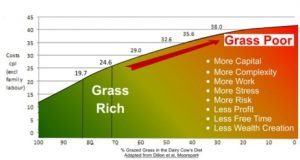Sheryl Brown
New Zealand and Irish dairy farmers need to focus on low-cost grass systems to be competitive in the future, Irish and NZ dairy farmer Michael Murphy says.
“Only NZ and Ireland live or die on pasture-based systems. We should be very mindful of the competitiveness of the grass-based industries as against the confinement industries over time.”
NZ and Ireland had similar dairy industries and together supplied 4.2% of the world’s milk.
Both countries were seasonal calving, grass-based and low cost and both had to be globally competitive in their niche, because the rest of the world’s milk supply came from grain-based confinement systems (80-85%) or a hybrid grain and grass system (10-15%).
‘Grass systems are highly competitive now. The question is will they be competitive in 10, 20, 30, 40 years. It’s a question NZ and Ireland should always be mindful of.’
In comparison to grain-based confinement systems, grass-based models had less research funding available to them and the potential to increase production was limited, he said.
These systems had about $7.5 billion in their research pot and with an average of 3% increase in productivity every year it had the potential to double productivity in 24 years, (using the Rule of 72).
That was compared to grass yield which only increased by 0.2% a year, and would take 360 years to double its yield.
“Grass systems are highly competitive now. The question is will they be competitive in 10, 20, 30, 40 years. It’s a question NZ and Ireland should always be mindful of.”
To remain competitive grass-based systems must remain low-cost and sustainable.
Farmers in Ireland and NZ had focused on production per cow or per hectare to the detriment of their profitability, Murphy said.
That focus on production had led to more intensification to drive more production which had in turn lifted expenses. In NZ for every $1 of bought-in feed the farm working costs had increased by 1.64 (Waikato) and $1.77 (Canterbury).

Farm working expenses in NZ lifted significantly after the payout lifted in 2007/08 and farmers responding by increasing the feed and subsequently costs. The farm working expenses had not really come back down since then, he said.
“That has led to much lower profitability and much higher debt on farms.”
Findings in NZ and Ireland showed the stronger correlation to profitability lay in focusing on low-cost systems. Low-cost systems correlated to 55% of profit in NZ, while focusing on production/ha was 33% and production/cow was just 17%.
“Yet people focus on increasing milk yield not dropping cost. And that is, I’m suggesting, the very wrong focus.”
Some farmers could go down the route of intensification and could achieve very high profit, but it’s only 3-5% of farmers that could make it work, he said.
“For 95% there is a cost to it and the cost is more capital, more complexity, more work, more stress, more risk, less profit, less time with the family.”
Alternatively, by increasing the percentage of grass in the cows’ diets meant more profit, more free time, more family time, better business options and more wealth creation.
The key was to keep the focus on profitability not profit, he said.
What drives profit
- Low cost 55%
- MS/ha 33%
- Yield/cow 17%
More stories from the Pasture Summit in the January edition of NZ Dairy Exporter.





